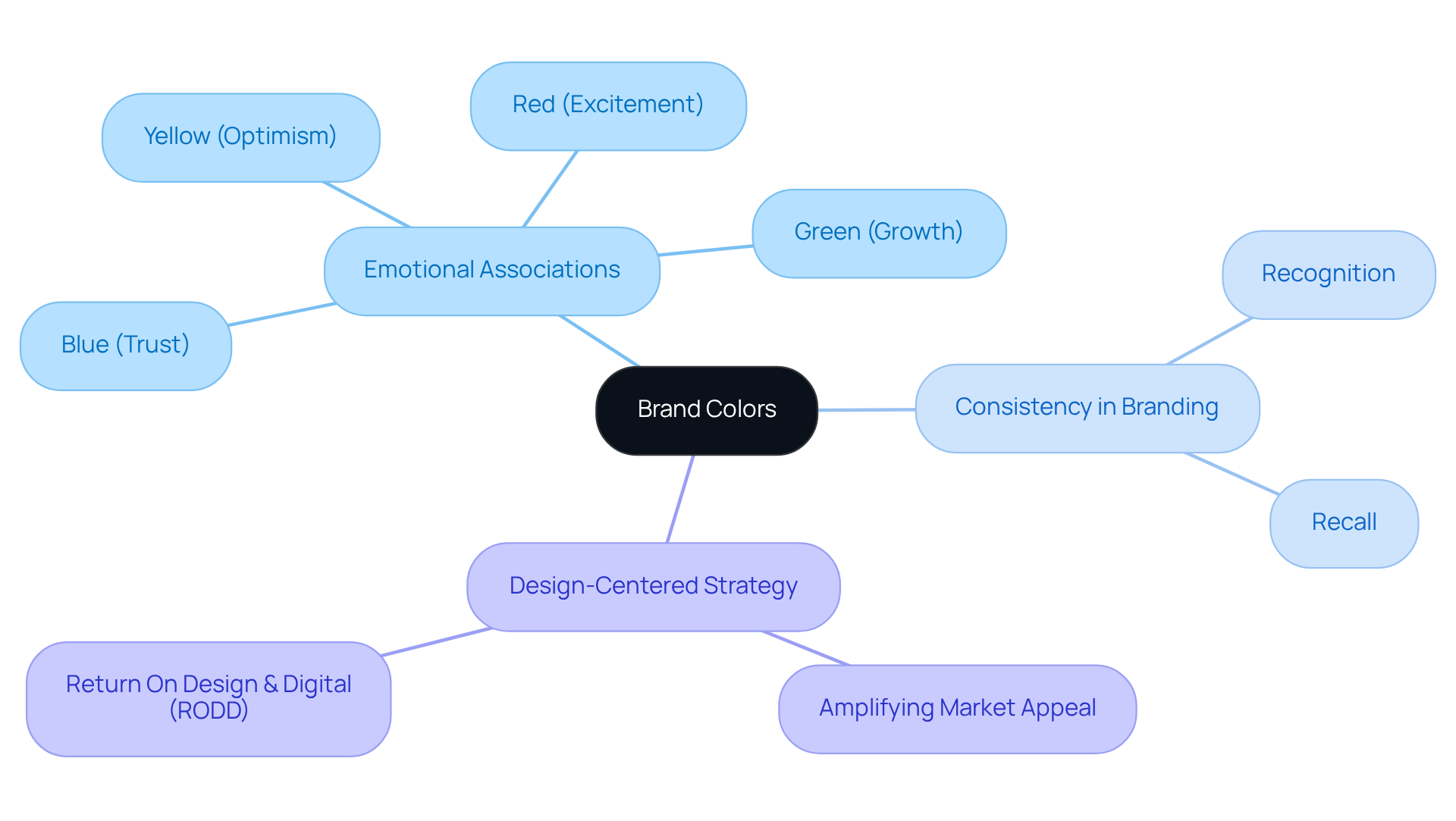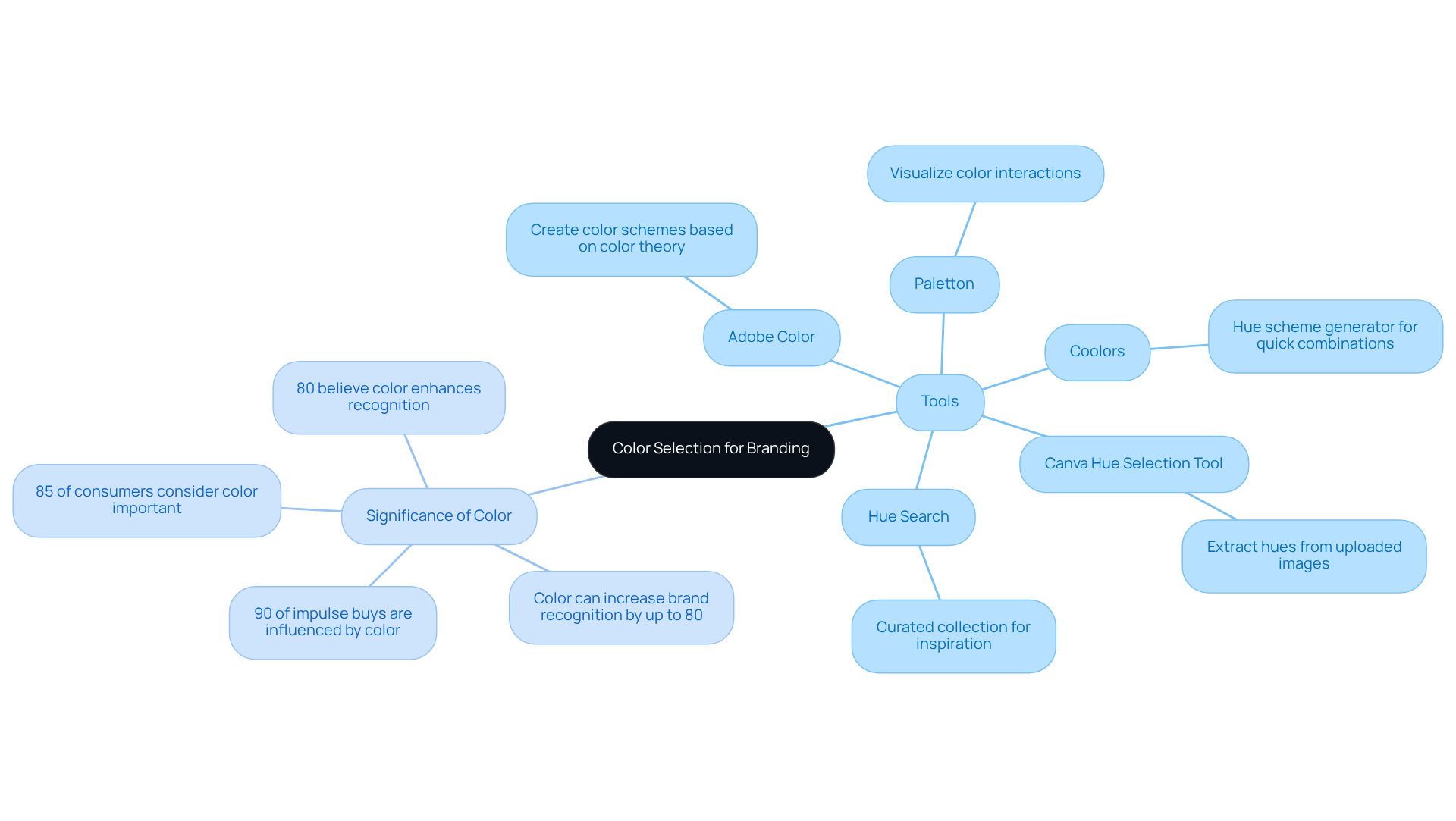Overview
Choosing the right brand colors can feel overwhelming for many startups. It's a common struggle that can leave founders anxious about how their choices might influence consumer perceptions and emotions. The fear of making the wrong decision can weigh heavily, especially when trying to establish a unique identity in a crowded market. But you’re not alone in this journey, and there is a way forward.
Understanding the significance of color in branding is vital. Colors can evoke feelings and shape how your audience perceives your brand. By defining your brand identity and researching your competitors, you can gain valuable insights into which colors resonate with your target audience. This process might seem daunting, but it’s a crucial step toward creating a cohesive color palette that truly reflects your brand’s essence.
Start by selecting your primary and secondary hues thoughtfully. Consider using various tools that can help you visualize and create a harmonious color scheme. Remember, this palette will be the first impression many consumers have of your brand, so take the time to ensure it resonates with them.
As you navigate this process, know that support is available. RNO1 is here to guide you through each step, providing the expertise you need to make informed decisions. Together, we can transform your vision into a reality, ensuring that your brand colors not only represent your identity but also connect deeply with your audience.
Introduction
Color is more than just a visual element; it is a powerful tool that shapes perceptions and influences consumer behavior. For many startups, the challenge of choosing brand colors can feel overwhelming. This choice often becomes a defining factor in establishing a unique identity that truly resonates with target audiences. Without the right hues, emerging businesses may struggle to stand out in a crowded marketplace, leaving them feeling disconnected from their customers.
This guide delves into the intricacies of selecting the right colors, highlighting their emotional impacts and the strategic processes involved. Together, we will explore how emerging businesses can harness the psychology of color to foster lasting connections with their customers, creating a brand identity that not only attracts attention but also builds trust and loyalty.
Understand the Importance of Brand Colors
Hue palettes are not just visual selections; they serve as powerful instruments that reflect your company's essence and principles. At RNO1, we understand that for startups, a is essential. The right hues can significantly shape how potential customers perceive their identity. Colors have the power to evoke specific emotions and associations, which can heavily influence purchasing decisions. For example, blue often conveys trust and reliability, while red can stir excitement and urgency. Grasping these connections is the first step towards crafting an engaging identity that truly resonates with your target audience.
Moreover, consistently applying your across all platforms enhances recognition, making it easier for customers to identify and recall your brand. This consistency is particularly vital in the bustling startup landscape, where standing out is crucial for success. By embracing , startups can amplify their market appeal through effective Return On . We invite you to reflect on your own experiences with color and branding, as together, we can navigate this journey towards a compelling identity.

Explore Color Meanings and Their Emotional Impact
A plays a crucial role in shaping and can evoke specific emotions that influence purchasing decisions. This can be a challenge for many startups trying to connect with their audience. It’s essential to understand how different colors are perceived to avoid potential pitfalls in your [colour brand](https://buildwithbolt.com/color-crash-course-using-color-in-your-brand).
- Red is synonymous with passion, energy, and urgency. It’s particularly effective for . As Jay Daggar notes, "For example, red communicates excitement, passion, and youthful zeal." Brands like Coca-Cola leverage the colour brand red to stimulate excitement and encourage immediate responses. When used thoughtfully, red can ignite a spark in your audience.
- Blue often evokes feelings of trust, calmness, and professionalism. It’s a favorite among tech and finance companies. Brands such as IBM and Facebook utilize blue to foster a sense of reliability and security. This color signifies dependability, calm, and trust—qualities that resonate deeply with consumers seeking stability.
- Green represents growth, health, and sustainability, appealing to eco-conscious consumers. Companies like Starbucks and BP use their colour brand green to highlight their commitment to environmental responsibility, enhancing their appeal to a growing market segment. However, it’s vital to be cautious of the risk of "green-washing" when using . Authenticity matters, and consumers can sense when a brand isn’t genuine.
- Yellow inspires optimism and cheerfulness, making it perfect for companies targeting a youthful audience. McDonald's effectively employs yellow to create a sense of happiness and energy, attracting children and families. This color can be a beacon of joy, inviting consumers to engage with your brand.
- Purple suggests luxury and creativity, often used by brands in the beauty and fashion industries, such as Hallmark and Cadbury, to position their products as premium options. It’s a color that can elevate your brand’s image, making it feel exclusive and desirable.
It’s important to note that 62%-90% of initial impressions are driven by hue, underscoring the significance of and consumer engagement. Furthermore, can influence color perception; a shade deemed fortunate in one culture may carry a different significance in another. This complexity can be daunting, but understanding these nuances can empower you.
By grasping these color associations, you can strategically choose shades that not only represent your identity but also connect emotionally with your target audience. This thoughtful approach can ultimately and loyalty, fostering a community around your colour brand. Remember, your choices matter, and they can create lasting impressions.
.](https://images.tely.ai/telyai/hohjgatq-the-central-node-represents-the-overall-theme-of-color-meanings-each-color-branch-describes-its-emotional-impact-associated-brands-and-relevant-cautions-this-layout-helps-you-see-how-colors-influence-brands-and-consumer-perceptions.webp)
Follow a Step-by-Step Process to Choose Your Brand Colors
Choosing your brand colors can sometimes feel overwhelming, but it can be streamlined into a systematic process that nurtures :
- Define Your : Start by articulating your brand's mission, values, and target audience. This foundational understanding will guide your , ensuring they resonate with your intended market and reflect who you are.
- Research Competitors: Take a moment to analyze the palette selections of your rivals within the industry. By identifying prevailing trends and gaps, you can discover unique opportunities that allow your company to shine in a crowded marketplace.
- Select Main Hues: Choose one or two primary shades that embody your identity's essence. These hues will serve as the foundation of your , shaping . Remember, research shows that 62-90% of individuals evaluate brands solely based on colors, making this decision crucial.
- Choose Secondary and Accent Hues: Select additional shades that harmonize with your primary selections. The 60-30-10 guideline can help you find balance: assign 60% to primary hues, 30% to secondary, and 10% to accent shades, creating a cohesive palette that feels just right.
- Test Your Palette: using your chosen shades, and invite feedback from prospective clients. Their responses can help you confirm that your hue selections effectively communicate your company's message. As Madeline Muzzi wisely noted, "There’s no universal best scheme for ecommerce," so customize your selection to reflect your unique character.
- Complete and Record: Once you feel satisfied with your choices, finalize your hue selection and document it in your style guidelines. This ensures uniformity across all platforms, strengthening your identity and enhancing recognition among your audience. Regular application of company hues can boost income by 23%, highlighting the importance of a clearly defined palette.
Moreover, consider leveraging as a valuable asset in creating your visual identity. like Strategy & Experience Guidelines and Identity Design, which can support you in crafting unique identities that resonate in the market. For instance, our illustrates how thoughtful hue strategies can enhance user engagement and brand recognition across digital platforms.

Utilize Tools and Resources for Effective Color Selection
Navigating the can be a daunting task for startups, often leaving founders feeling overwhelmed. It's not just about picking a color; it's about establishing an identity that resonates with your audience. The implications of a colour brand choice are significant, influencing everything from to . Fortunately, there are several invaluable tools and resources to help you on this journey:
- Adobe Color: This robust tool allows you to create based on established color theory principles. You can explore popular and craft personalized palettes tailored to your company's unique needs.
- Coolors: An intuitive hue scheme generator, Coolors makes it easy to quickly create and save combinations, allowing you to experiment with different looks effortlessly.
- Canva Hue Selection Tool: By simply uploading an image, you can extract a selection of hues that inspire you, ensuring that your brand's colors resonate with your aesthetic and vision.
- Hue Search: This curated collection of beautiful arrangements can spark inspiration for your company's color scheme, helping you uncover combinations that truly stand out.
- Paletton: This palette designer lets you visualize how colors interact in various contexts, guiding you toward harmonious combinations that reflect your brand's essence.
Utilizing these tools can simplify the hue selection process, ensuring that your final choices are not only visually appealing but also strategically aligned with your colour brand identity. Remember, 85% of consumers indicate that , while 80% believe that . As you choose your colors, consider the , as they can profoundly impact how your brand is perceived in different markets. For instance, while blue often symbolizes trust and stability, red can represent luck in certain cultures, as seen in how Apple adapts its branding for the Chinese New Year.
By leveraging these tools and insights, you can create a colour brand palette that not only reflects your brand's identity but also resonates deeply with your target audience. Together, let's embark on this colorful journey and ensure your brand shines brightly in the marketplace.

Conclusion
Choosing the right brand colors can feel overwhelming for startups striving to create a strong and memorable identity. This decision is not merely aesthetic; it carries the weight of communicating your brand's values and evoking emotions that significantly influence how consumers perceive and engage with your business. Understanding the psychology behind colors and their emotional resonance is essential. By doing so, you can cultivate a visual identity that deeply connects with your target audience, fostering loyalty and trust.
Throughout this guide, we have explored the importance of brand colors, illustrating how specific hues like red, blue, green, yellow, and purple shape consumer experiences. This systematic approach—from defining your brand identity to utilizing effective tools—offers a clear pathway for crafting a cohesive and impactful color palette. By leveraging insights into color meanings and the emotional connections they inspire, you can strategically position your startup in the marketplace.
Ultimately, the choice of brand colors is a powerful opportunity to drive engagement and recognition. We encourage you to embrace this chance to thoughtfully select your colors, ensuring they align with your brand identity and resonate with your audience. As the landscape of branding evolves, understanding the significance of color in marketing will remain a vital component for your success in 2025 and beyond. Remember, you are not alone in this journey; we are here to support you every step of the way.
Frequently Asked Questions
Why are brand colors important for a company?
Brand colors are important because they reflect a company's essence and principles, influencing how potential customers perceive the brand. They can evoke specific emotions and associations that significantly impact purchasing decisions.
How do colors affect customer perception?
Colors can evoke specific emotions; for instance, blue often conveys trust and reliability, while red can create excitement and urgency. These associations can heavily influence how customers view and engage with a brand.
What is the significance of consistency in applying brand colors?
Consistently applying brand colors across all platforms enhances brand recognition, making it easier for customers to identify and recall the brand. This consistency is crucial for startups aiming to stand out in a competitive market.
How can startups benefit from a design-centered strategy regarding brand colors?
Startups can benefit from a design-centered strategy by amplifying their market appeal through effective Return On Design & Digital (RODD) strategies, which help create a compelling identity that resonates with their target audience.
What should companies consider when choosing their brand colors?
Companies should consider how different colors evoke emotions and associations, and how these can align with their brand values and target audience preferences to craft an engaging identity.




